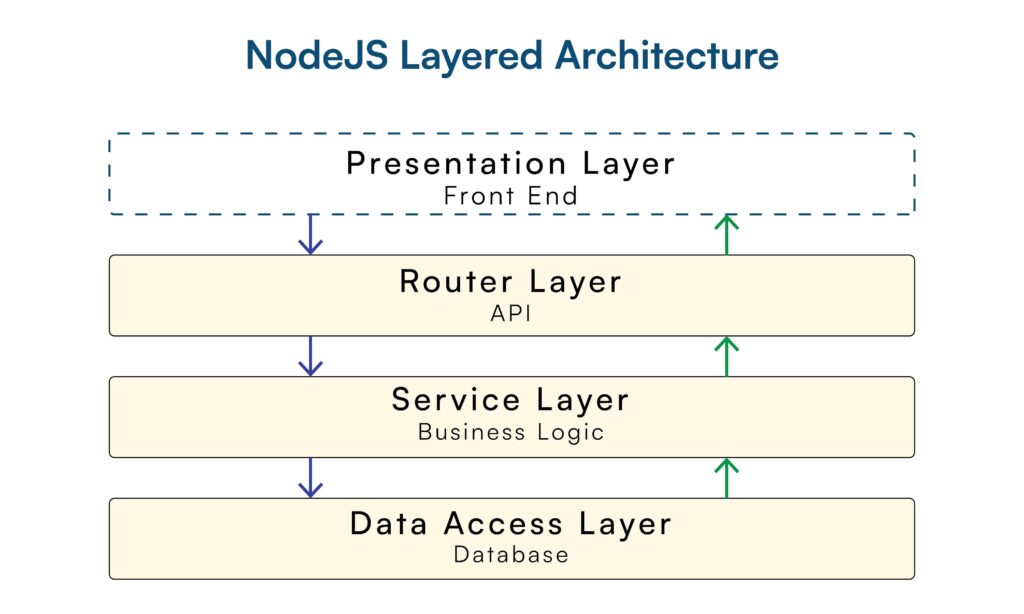As a backend JS (JavaScript) runtime environment supporting cross-platforms (like Windows, Linux, Unix, and macOS), Node JS has so far taken a revolutionary journey since the official confirmation of its existential identity in 2009 by its writer, Ryan Dahl. Based on Google Chrome’s V8 JavaScript Engine, today this open-source server environment is being used comprehensively by developers worldwide to build real-time, fast, and scalable network applications.
For instance, a curious case of Netflix having significantly reduced its loading time by 70% and visibly more improved front-end to back-end transition with lower latency is an authentic validation of Node js. For the uninitiated, Node JS is lightweight and efficient. It uses the asynchronous mode of operation and non-blocking.
What Makes Software Architecture An Absolute Necessity?
The baseline for any project is good software architecture. A technical blueprint of its own, the architecture constitutes all essential components facilitating design decisions corresponding to overall system structure and behavior. As a result, it helps you to understand even the abstract system complexity.
Otherwise, messy project architecture could pronounce a herculean task for developers leading to ramifications, such as –
- It prolongs the development process. As a result, problems regarding the testing of the product itself are bound to surface
- A clumsy architecture leads to annoying repetition, causing problems in the maintenance and management of codes
- It makes deploying new features (without disturbing existing ones) a time-consuming task
The objectives of the Node JS project include helping you write clean and easy-to-read code, avoid repetition, and add new features without messing up existing code.
Explaining Node JS Architecture
Software architecture has long been proven as an essential decision-making tool to understand and analyze the latent capability of a system’s modifiability, availability, and security. Node JS architecture is based on a similar modus operandi. It’s a platform using “Single Threaded Event Loop” architecture to process multiple clients’ requests concurrently. Note that Node JS follows a single-threaded with an event loop model, not a request/response multi-threaded stateless model.
Key Essentials Of Node JS Architecture
- The architecture is based on a single-threaded event loop
- It doesn’t use a request/response multi-threaded stateless model
- It doesn’t cause problems in processing multiple clients’ requests at the same time
- It has a key component processing model called Event Loop
- It uses an Asynchronous model and Non-blocking of I/O operations
Key Areas Of Node JS Architecture
a) Requests – There are two types of requests – incoming and outgoing. They are based on blocking/complex or non-blocking/simple patterns.
b) Node JS Server – Users send requests to the server-side platform which are then processed and sent back to the corresponding users.
c) Event Queue – All the incoming client requests are stored here which are then passed onto the Event Loop in sequence.
d) Event Loop – Requests are received, processed, and sent back to the corresponding clients.
e) Thread Pool – It’s a repository of all the threads to be processed conforming to the client’s requests.
f) External Resources – They are designed for various purposes, like blocking client requests, data storage, computation, etc.
Five Best Practices For Node JS Application Architecture
Best Practice #01 – Follow Layered Approach
A layered architecture indicates a pattern used in software development in which roles and responsibilities are defined based on layer-wise separation. The objective is to follow the “Separation of Concerns” programming principle that warrants the necessity of distinct modules to address distinct concerns in an application.
In simple words, layers can be organized to facilitate the execution of specific/distinct roles within the app.
Node JS layered architecture involves components, such as:-
- Presentation Layer
- Router Layer (API)
- Service Layer (Business Logic)
- Data Access Layer (Database)

The goal behind following a layered approach in Node JS is to discrete concerns among components. In other words, the layered approach simplifies creating, maintaining, debugging, and testing your Node JS apps.
Best Practice #02 – Create A Folder Structure To Organize Code Files
A folder structure is like a repository for the group and organizes common elements. It allows you to transform your chosen layered approach into reality. You can also organize diverse modules into discrete folders. Moreover, a folder structure also spells out various classes, methods, and functionalities used in the app.
Best Practice #03 – Use Publisher/Subscriber Models
The publisher/subscriber models allow developers to communicate between two communicating entities, such as publishers and subscribers. It is like a data exchange pattern. For example, publishers send out messages via specific channels have no identifiable recipient system. Similarly, subscribers are clueless about publishing entities while dealing with one or more channels.
This model is a good practice that allows you to manage various children’s operations linked to a single action. Besides, the model facilitates distributing caching effectively without waiting for the client’s request to seed the cache, thus improving app performance significantly.
Best Practice #04 – Use Dependency Injection
Node JS comes equipped with some of the most interesting features and tools designed to streamline software engineering objectives easily. However, it doesn’t mean to say that problems like dependencies could not be free from trouble. That’s because dependencies could be problematic regarding testability and code manageability. This is where dependency injection comes off as a good solution to the developers’ problems.
Dependency Injection (DI) can be defined as a design pattern in software engineering in which a data structure/function or a variable (object) relies on corresponding objects that it receives. Basically, in dependency injection, the kind of variables an object requires are provided instantly. It is just a programming technique designed to make a class independent of its dependencies. You can also say DI advocates firmly against configuring a class’s dependencies statically.
When you create objects directly within the class, the process becomes inflexible due to committing the class to specific objects. As a result, it makes the process difficult to eventually change the instantiation independently from the class. In that case, it affects the reusability of the class when the requirement of other objects arises, thus posing a problem in the testability of the class, as mock objects are not an effective replacement for the real ones.
Using DI generates some striking benefits for your Node JS apps, such as –
- You can pass dependencies straightway to the modules of your requirement rather than hardcoding the same. As a result, you can make the unit testing process properly streamlined
- You will relieve yourself from the hassle of useless module coupling, thereby helping you to deal with the maintenance comfortably
- Makes your git flow faster, as your defined interfaces remain unchangeable. It rules out any possibility of merging conflicts
Best Practice #05 – Implement Unit Testing
For any software application to have a better lifespan and functionality, the importance of unit testing is undeniable. When you’re developing applications, testing the whole gamut of project elements is an important stage to avoid the downsides, like slowing down the development process and other problems in the future due to buggy or messy code.
Unit testing is a common way of testing applications that aims at isolating a section of code and validating its accuracy. With unit testing, you can fix bugs in the early development cycle of applications and save costs.
You can read one of our blogs about Software Testing as a Service to learn more about software testing.
Benefits of Unit Testing Approach:
- It helps you determine the quality of your code
- It helps you figure out any possible bugs missed in your earlier inspection before the code is finalized for the next stages of development
- It ensures earlier detection of bugs or any issues so that you don’t have to take the trouble of handling the brain-teasing process of debugging
- It helps you rule out the possibility of debugging your application later. This means saving costs on your project. Time spent less on debugging means cost saved more
Other Practices For Node JS Application Architecture In Brief:
- Use the linter tool to speed up the development process of your applications and improve their quality. It will also allow you to keep the whole application code uniform while monitoring errors
- Use a better style guide to improve the readability of your code
- Using Gzip compression can help you reduce the file sizes before migrating them to a web browser. It could also mean reducing latency and lag
- Using promises in Node JS will improve the readability and testability of your code
Conclusion
Node JS development is a delicate process because of the various challenges it involves. However, deploying Node JS best practices as mentioned above would help you make an informed decision about what type of Node JS architecture you should use and the types of Node JS best practices you should adopt to support the chosen architecture. Besides, you can get in touch with a software development company for Nodejs development services.
It should be borne in mind that Node JS has an asynchronous and non-blocking nature, thereby capacitating it to process a huge volume of information (terabytes) efficiently. Besides, the architecture is competent in handling many users concurrently.
As a leading software development company, we have helped various clients build enterprise-level Node JS applications, helping them streamline voluminous data in real-time and experience great business value. We help businesses build modern, scalable, and reliable apps. Our robust backend engineering solutions can streamline the operational excellence of your business, helping you stay competitive in your niche.










